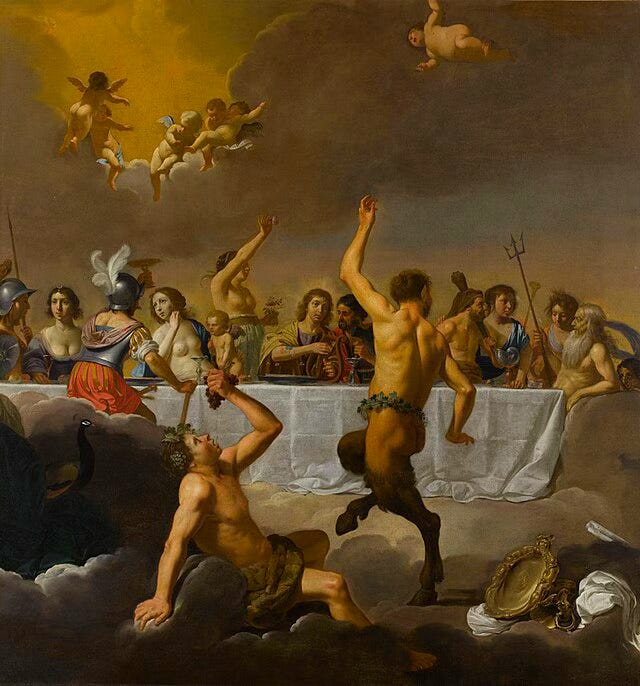This summer’s Olympics opened with a neo-pagan travesty of Christ’s last supper. That’s not an accusation or a polemic. It’s just a description, in the plainest available English words, of what happened last Friday: drag performers satirically re-clothed (travestied) a famous type-scene from Western art, using modern updates of pre-Christian (neo-pagan) symbols. The instant denials and revisions that followed were intended not so much to convince people otherwise as to entangle them in a thicket of explanations and counter-explanations so that they would find it impossible to discuss the affair in simple terms.
Otherwise they might move on from describing the performance accurately to noticing interesting things about it, like the fact that it was hopelessly drab and ugly. An actual pagan—one of the ancient ones—would have retched. This is probably the most significant feature of the event, the fact that will remain important long after this little media wavelet has crested.
Neo-paganism is not the same thing as paganism: when ancient patterns of ritual and myth work their way into the void left by Christianity, they come sapped of the manly vigor and tragic nobility that once made them what they were. Old forms of nature-worship that died long ago are being dragged out of their graves limp and mangled, in a desecration not just of Christianity but of the religions Christianity replaced. It’s what you might call Zombie Paganism.
The centerpiece of the Olympics performance was a man, Philippe Katerine, painted in blue and served almost naked on a platter in a spoof of Bacchus, the Greek and Roman god of revelry. When the backlash hit, Katerine and his supporters protested that he was actually recreating Jan van Bijlert’s 17th-century painting of the Olympian gods.
In charity, it’s fair to note that artists often do work from multiple sources of inspiration. But of course that includes van Bijlert, who, as the museum housing his work conceded, was using the Olympian scene to recreate...the last supper. The association is so impossible to avoid that, as Jonathan Pageau pointed out, witty observers called Katerine’s tableau “la scène de la Cène sur la Seine,” a French pun meaning “the Scene of the Last Supper on the Seine.”
It’s less interesting to haggle over the artist’s various streams of influence than to notice that they all flow, like tributaries of one great river, from Christ. Katerine’s Bacchus is trapped on the apostles’ table: try as he might to escape, he exists, as Kamala Harris might say, in the context of all that came before him. The Christian story has stamped itself so deeply into the Western imagination that Katerine’s pagan imagery remains stuck in a Christian frame, where it appears offensive and ridiculous rather than majestic or beautiful. It cannot help but be a parody.
The Bacchus of Greek myth was the embodiment of wild abandon and intoxicating extremes. But Katerine’s zombie pagan version is neither the hypnotically seductive waif of Euripides’ Bacchae, nor the intentionally hilarious buffoon of Aristophanes’ Frogs. He is an earnest little smurf in a jock strap, cooing and jiggling his way through a nudist French knock-off of John Lennon’s “Imagine” (the lyrics translate to banalities like “there would be no more rich and poor if we all went back to being naked”). To call such images perverse is again not to use a pejorative but a descriptor: when you unbury dead things, they come up twisted.
As John Daniel Davidson recently argued, and as T.S. Eliot observed before him, “the choice before us is between the formation of a new Christian culture, and the acceptance of a pagan one.” But a culture that was formed for centuries by Christian teaching can only revert to full-fledged paganism through a process of violent contortion. The resulting product is not the wholesomely naked innocence imagined by primitivists like Lennon and Katerine, but something altogether more sickly and malformed.
Take as an extreme instance the case of suicide. “Medical Assistance in Dying” (MAiD) was legalized in Canada less than ten years ago. In that time, despite condescending assurances that this would never happen from all the usual corners, the procedure has morphed from a last resort for the terminally ill into a recommended exit route from life for undesirables. The socialist magazine Jacobin reported this year that “poverty is driving disabled Canadians to consider MAiD.” The logic here would be familiar to any Roman legionary: when every other path to agency is closed, “death with dignity” is the only way.
But the Stoic philosophers thought in all sincerity that by ending their lives they could submit themselves dutifully to a natural cycle of life and death, re-integrating their souls to the cosmic order. Whatever measure of peace they found in the prospect, it came from their deep-set belief that their lives were part of a grander design. When Marcus Aurelius contemplated taking leave of life, he pictured doing it “not in anger, but matter-of-factly, straightforwardly.”
The souls who pitch themselves into the void today out of hopelessness or despair are following a dreary rewrite of this pagan script. But it is set for them by a society that makes no promises of meaning on the other side. Where the soldiers of antiquity fell on their swords for honor, the victims of zombie paganism drift sadly offstage for lack of better options.
The horror and pity we rightly feel at this miserable situation gives us away as Christians at heart, even when we try to deny it. Christianity barred the pagan’s way out of life forever, as Hamlet discovered to his chagrin. It impressed upon us all the conviction that human souls do not simply return to the Stoic’s peaceful oblivion but carry on into eternity, where the marks of our actions in this life stay printed upon us forever.
It’s heartbreaking to watch a culture grope for secular justifications of its best moral principles when it’s been deprived of the ancestral faith that taught them. Consider the Reddit commenter who, casting about for an explanation of the prohibition against suicide, referred to “the current social stigma attached to it.” He probably had no idea how truly he spoke: even now the mark of the cross is etched painfully into the Western psyche like nail marks on the palms of our hands, made known in the little pangs of disgust and sorrow that haunt us when we try to live like the ancient pagans. Christ left us no viable way back into a healthy pre-Christian past. He never intended to.
So there must be a way forward. At the same time as zombie paganism has been slouching across our cultural landscape, a growing number of first-rate scholars and public figures have been coming to grips with the Christian underpinnings of our civilization. Tom Holland. Glenn Scrivener. Ayaan Hirsi-Ali. Justin Brierley. The list is long, and getting longer.
Each in his or her way has made the case that practically every element of our past we might wish to carry into the future—from individual liberty and human rights to the nation-state and the scientific enterprise—is a product of what Holland calls “the Christian revolution.” This calls to mind another of Eliot’s warnings, that “to justify Christianity because it provides a foundation of morality, instead of showing the necessity of Christian morality from the truth of Christianity, is a very dangerous inversion.” You won’t get the tree without the roots.
All the same, the soil may be more fertile than it looks. People started turning to zombie paganism not just out of decadence but also out of nostalgia: where the old formulations of Christianity have failed to carry conviction, it may be in part because they have lost what was good in the old formulations of paganism. The Stoic’s fanatical commitment to virtue. The Bacchic dancer’s crazed devotion to the overpowering madness of beauty. The Eleusinian initiate’s reverence for the solemnities of nature. People crave these things. They are part of the fullness of life.
If ancient paganism stopped being able deliver them, it’s because ancient Christianity won the day by affirming “whatsoever was true, lovely, and of good report” in the old festivals. That’s why it gets more absurd every year when some online sage, fresh from reading his first book, announces his discovery that Christmas is just an old Roman holiday or festival of the sun. An ancient Christian would reply: it’s just like that, and better. Zombie paganism comes back drained of its vital spirits because Christianity absorbed them long ago.
It follows that the path to anything like a good or wholesome pagan revival must run through a Christian revival. “Christianity is the only frame which has preserved the pleasure of Paganism,” wrote G.K. Chesterton. No doubt about it, our task is to recover the old beauties, the old verities, the old virtues. But if we want them vigorous and alive, we must not go looking for them in their antique graves. They are not there: they have risen, with their Lord.






This is my favorite essay of yours, Spencer, since I joined the group. So rich, so layered, so well written. It’s worth a few read throughs and I thank you sincerely for it.
Wow. This is my favorite essay of yours thus far - and I thought everything had already been said about the Last Supper Olympic travesty.